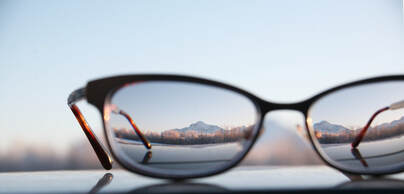Myopia

Nearsightedness, or myopia, as it is medically termed, is a vision condition in which near objects are seen clearly, but distant objects do not come into proper focus. It occurs when light entering your eye through the lens on the front surface (the cornea) is not focused correctly onto the back of they eye (the retina). It is most commonly caused by an eyeball that is too long but can also occur when the front surface (the cornea) is too steep. You can think of it like a projector that is set too far from a screen and results in an out of focus image.
Nearsightedness is a very common vision condition that affects nearly 40 percent of the U.S. population. Some evidence supports the theory that nearsightedness is hereditary, and there is also some evidence that nearsightedness may be caused by the stress of too much close vision work. It is normally diagnosed in school-age children, because the eyes tend to grow longer while children are growing. In fact large growth spurts are often accompanied by increased nearsightedness, and nearsightedness tends to stabilize once children stop growing.
Nearsightedness ranges from 0.00 (none) to -20.00 or more . Less than -3.00 is usually considered a small amount. At about -3.00 or worse most people have trouble even seeing the big "E" on the eye chart without their glasses or contacts. -3.00 to -6.00 is considered a medium amount, and -6.00 or more is considered a high amount.
Signs of nearsightedness include difficulty seeing distant objects like a movie or TV screen or classroom board. A comprehensive eye examination with a refraction (measurement of prescription) will include testing for nearsightedness. Correction of nearsightedness usually includes eyeglasses or contact lenses to refocus light properly onto the back surface of the eye (the retina). In mild cases of myopia, glasses may only need to be worn for certain activities, like watching TV or a movie or driving a car, but with larger amounts of myopia glasses or contacts may need to be worn for all activities.
Refractive surgery or laser procedures are also possible treatments for nearsightedness as is orthokeratology. Orthokeratology (ortho-k) is a non-invasive procedure that involves the wearing of a series of specially-designed rigid contact lenses to progressively reshape the curvature of the cornea over time. Another option would be myopia control that can slow the progression of nearsightedness. Myopia control can be accomplished with drops, multifocal soft contact lenses, or rigid contact lenses.
Nearsightedness is a very common vision condition that affects nearly 40 percent of the U.S. population. Some evidence supports the theory that nearsightedness is hereditary, and there is also some evidence that nearsightedness may be caused by the stress of too much close vision work. It is normally diagnosed in school-age children, because the eyes tend to grow longer while children are growing. In fact large growth spurts are often accompanied by increased nearsightedness, and nearsightedness tends to stabilize once children stop growing.
Nearsightedness ranges from 0.00 (none) to -20.00 or more . Less than -3.00 is usually considered a small amount. At about -3.00 or worse most people have trouble even seeing the big "E" on the eye chart without their glasses or contacts. -3.00 to -6.00 is considered a medium amount, and -6.00 or more is considered a high amount.
Signs of nearsightedness include difficulty seeing distant objects like a movie or TV screen or classroom board. A comprehensive eye examination with a refraction (measurement of prescription) will include testing for nearsightedness. Correction of nearsightedness usually includes eyeglasses or contact lenses to refocus light properly onto the back surface of the eye (the retina). In mild cases of myopia, glasses may only need to be worn for certain activities, like watching TV or a movie or driving a car, but with larger amounts of myopia glasses or contacts may need to be worn for all activities.
Refractive surgery or laser procedures are also possible treatments for nearsightedness as is orthokeratology. Orthokeratology (ortho-k) is a non-invasive procedure that involves the wearing of a series of specially-designed rigid contact lenses to progressively reshape the curvature of the cornea over time. Another option would be myopia control that can slow the progression of nearsightedness. Myopia control can be accomplished with drops, multifocal soft contact lenses, or rigid contact lenses.

